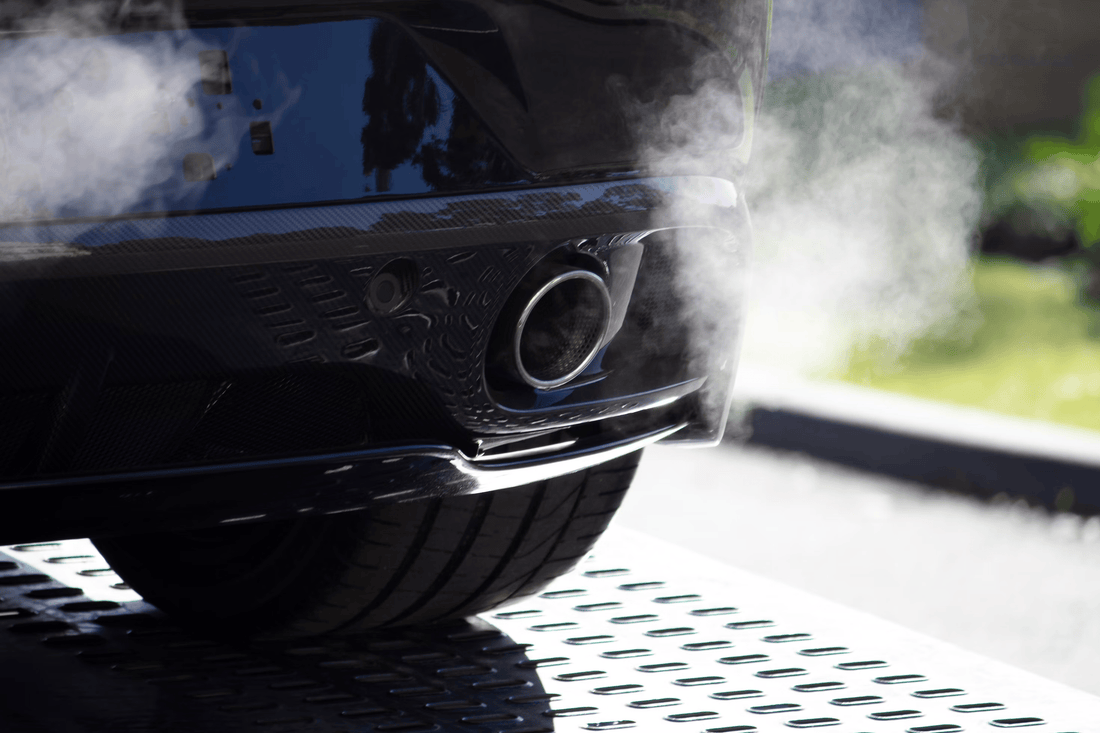You're driving, cruising through backroads. Life is good.
A cloud of billowing white smoke arises in your rearview. And now your heart’s racing.
White smoke coming from your exhaust is a clear cry for help from your vehicle. But what’s causing it, and how can you fix it? Keep reading to find out the top reasons why white smoke might be coming out of your exhaust. We’ll also address a few ways to diagnose and potentially fix the problem before it affects the rest of your vehicle.
1. Cracked Head Gasket
While there could be many causes of the white smoke coming from your exhaust, many issues are due to a cracked head gasket.
Within an internal combustion engine, the head gasket is responsible for keeping combustion gases contained within the cylinders at all times. If this seal is blown, coolant and/or engine oil could leak into the combustion chamber.
Depending on the state of damage, you can try a head gasket repair treatment to prevent any further damage from happening. Keep in mind though that these store-bought sealers are only a temporary fix.
2. Cracked Engine Block
A fault in the engine block can also expose coolant to the combustion process, leading to puffs of white smoke coming from your tailpipe. While possible, cracked engine blocks are extremely rare. This is because the head gasket is designed to fail first.
If you discover a breach in the engine block, you could have additional breaches in your engine, like the head gasket. Fret not as an engine block breach does not mean you need to replace your entire engine. To prevent the cracks from spreading, apply a block sealer. These sealing agents could save you thousands in repairs, helping you get back on the road sooner. Just remember to thoroughly clean and degrease the area before applying any sealant.
3. Cracked Cylinder Head
The cylinder head takes on the brunt of your vehicle's demands. It's the space where air and fuel are fed to the cylinders, making the entire combustion process possible. Due to its unique function, it must constantly be able to handle changes in temperature and pressure.
While not as common as cracked head gaskets, cracked cylinder heads are more common than faults within the engine block. Cylinder heads can get damaged in a variety of ways including:
- Vibration
- Poor design
- Age of the vehicle
- Not addressing and fixing issues with a vehicle that frequently overheats
A sealing agent can help to temporarily fill any head cracks. If your cylinder head is warped though (due to extreme heat and pressure), you may need to have it realigned, or replaced entirely. If left as is, warped cylinder heads can lead to further problems with your head gasket.
4. Botched Prior Repairs
You just got some work done on your ride and now it's coughing up thick white smoke. What happened? Is something else wrong with the vehicle now?
More repairs, more money. But maybe it’s not your fault. Sometimes during repairs, mechanics need to temporarily move components around in your vehicle. Sometimes these components, such as cylinder heads, are not refitted correctly, causing coolant to leak into the combustion chamber.
If you find your vehicle is emitting white smoke not long after you’ve made repairs, get your mechanic to have another look at the problem.
5. Engine Oil Contamination
Check your engine oil recently and noticed that something looks a bit off?
When you check your dipstick the oil should be slightly brown and transparent. If it looks thick and foamy, chances are there is a breach in your engine, and most likely it’s the head gasket.
Why does your engine oil look foamy? This is due to coolant leaking into the engine. Unlike oil, coolant isn’t designed for lubrication. If you let this problem linger, it could ruin other parts of your vehicle turning a simple head gasket repair into a much more expensive situation.
Our first point of call is to check your head gasket. If there are no issues there, examine the cylinder head and then the engine. Make proper repairs (e.g. apply sealant, find a replacement part) as necessary.
6. Coolant Contamination
If coolant is in your engine oil, chances are engine oil is probably mixing with your coolant.
This doesn’t happen overnight but occurs overtime due to a preexisting problem (gasket, cylinder head, or block) that has yet to be discovered. As coolant leaks into the engine, oil also finds its way into the cooling system, further exacerbating the problem.
How do you know if something is off? If your coolant looks thick, foamy, and possibly creamy in colour, oil has found its way into the coolant. Find the source of the breach by troubleshooting the head gasket, cylinder head, and engine block. Diagnose and fix the problem or replace the part if necessary.
7. Your Vehicle Can’t Temperature Regulate

Is white smoke coming from your exhaust and your temperature gauge swings wildly while you’re driving?
When these two problems occur in conjunction, it’s a telling sign that there is a crack in one of your engine components. Vehicles can overheat for a variety of reasons. Yet this unique situation is indicative of a cooling system that is being overworked.
Coolant is leaking into the engine, mixing with oil and air, and emitting white smoke from the exhaust. The cooling system has lower levels of coolant, yet still needs to do the same amount of work. The system can’t keep up and your car overheats.
If you have an abnormally high temperature gauge along with white smoke, find the source of the breach by troubleshooting the head gasket, cylinder head, and engine block. Diagnose and fix the problem or replace the part if necessary.
8. Your Ride is Too Souped-Up
We all want to get the most performance out of our rides. In striving for the highest standards of performance, too much boost could end up being a detriment to your vehicle.
If you recently upgraded your vehicle and you discover white smoke dragging out of your exhaust frequently. It’s time to take a look under the hood. Some aftermarket components may not pair well with others. Some cylinder heads may not be able to withstand the pressure of a souped-up engine.
Before upgrading your vehicle do the proper research beforehand to get an understanding of which parts will work best in your vehicle. Our team can also guide you in the right direction, helping you make the best decision before you shell out your hard-earned cash on a piece of new hardware.
9. You’re Using Low Octane Fuel
Low-octane fuel is cheap, and there is a reason why. The octane rating is an indicator of how efficient a fuel is. The higher the number, the better the fuel is at withstanding compression in the combustion chamber.
Low-octane fuel has a low compression threshold, if driving on low octane in extreme conditions (e.g. off-roading, extreme weather, steep terrain) it could multiply the stress put on your vehicle. Cracks can occur, causing coolant leaks and then the dreaded white smoke.
10. Fix White Smoke Coming From Your Exhaust
When your exhaust starts playing up, it’s a clear indication that something is off under the hood. With the tips above, you'll be able to diagnose the problem quickly, preventing any further damage to your vehicle.
At DEA Performance, we’re all about helping drivers get the most out of their vehicles. We offer a diverse selection of aftermarket car parts and mods designed for peak performance and longevity. Check out the blog for more tips, or shop our emission control systems to help you keep exhaust smoke at bay.
FAQs
What does dark smoke coming from my exhaust mean?
When too much oil gets into the combustion cycle, dark smoke tends to occur. Deteriorated piston rings are the most common culprit, as engine oil can leak past the worn-down rings and enter the cylinder. If you find your oil usage is increasing significantly, this could be the reason why.
What does blue smoke coming from my exhaust mean?
Blue smoke is also indicative of oil finding its way into the wrong places. When oil enters your exhaust system, it sometimes remains there even after the car is off. While your car is off, oil mixes with surrounding moisture in the air. When you fire up the vehicle the following day, this oil/air mixture is burned, creating blue smoke. There could be several reasons why this is happening, but engine seals are the most common reason.
Is it normal for a little white smoke from exhaust?
A little white smoke when starting up your vehicle usually isn’t an issue. This is often vapour, created when hot exhaust fires out of a cold vehicle. It’s the same effect that happens when you exhale air on a cold winter day.
If the volume of smoke increases and remains persistent though, it’s time to start troubleshooting your vehicle.
























